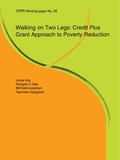Walking on two legs: Credit plus grant approach to poverty reduction
Abstract
There is a growing recognition that the ultra-poor are generally not integrated into the current anti-poverty programs. In this paper, we estimate the long-run impacts of a credit plus grant approach, a combination of microcredit, training and some grants, mostly in the form of consumption stipend, on the livelihoods of the ultra-poor. Using longitudinal panel data (2012-2016), we show that the intervention increased labour supply, income, and food consumption. We also document a large positive effect on productive assets. The effects on most of the outcomes of interest have been found to be increasing over time. For instance, the program increased productive asset values by 142 per cent and 259 per cent in the short-run (after two years of the intervention) and long-run (after four years of the intervention), respectively. Similarly, per capita real income increased by 37 per cent in the long run against 35 per cent in the short run. We also document positive effects on non-food expenditure and savings behaviour. Cost-benefit analysis shows that the average benefits of the program are 6.65 times larger than its costs. These findings indicate that microcredit can sustainably reduce ultra-poverty if some additional supports are combined with it.

